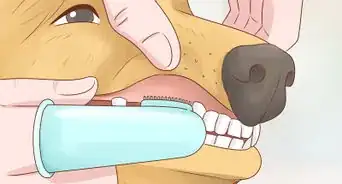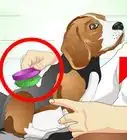This article was co-authored by Allison Weeks. Allison Weeks is a Dog Training Professional, as well as the Owner & Operator of Peticularly Perfect. With more than 12 years of experience, she specializes in dog walking, dog psychology, and dog behavior. Peticularly Perfect won the Best of Escondido business award for the pet care category in 2020 and Allison was featured as the owner of Peticularly Perfect in SD Voyager online magazine. Allison earned a Bachelor's Degree from Kaplan University.
This article has been viewed 121,329 times.
A healthy dog regulates its water intake naturally. When it is thirsty it drinks enough water to replenish its body. Sick dogs, on the other hand, may not do this and may become dehydrated. Thus, when you have a sick dog you will need to monitor its food and water intake closely and find a way to make sure your sick pal is getting the water it needs.
Steps
Assessing Your Dog's Water Intake
-
1Watch for changes in water consumption when your dog is sick. When a dog is sick its behaviors can change drastically. Pay attention to your dog's eating and drinking routines, looking for large changes. You want to catch dehydration early, before it causes an additional medical problem for your dog.
-
2Measure how much your dog is drinking. Give your dog a specific amount of water and see how fast it drinks it. While there may be variation, for the most part each dog requires from 44-66 mL of water per kg of body weight. That is ½ to 1 ½ ounces of water per pound of body weight.[1]
- In other words, a 10 pound dog should drink roughly a cup of water a day or a large 60 pound dog should drink 2 quarts of water a day.
Advertisement -
3Take variable factors into consideration. You will need to take into account a few things when estimating your dog's water needs. In hot and humid weather a dog will need to drink more water. In addition, if your dog is exercising heavily it will need more water. When a dog pants to cool off it loses more water than if it is at home relaxing on your couch.
- Dogs in these conditions may need twice the amount of water as normal.
-
4Work with your veterinarian to get your dog's disease condition under control. Sometimes treating the disease adequately will make your dog feel better and have a healthier appetite for both food and water. In these cases the dehydration will usually clear up on its own.
- Be aware that some medications used to treat congestive heart failure, like diuretics, will make monitoring water intake on your dog very important. Diuretics can cause severe dehydration.
Increasing Your Dog's Water Intake
-
1Encourage your dog to drink. Try to lure it nicely to its bowl. If you have a dog that is sick there is chance that it won't be interested much in eating or drinking. For some illnesses, such as simple gastrointestinal upset in a normally healthy dog, this isn't too worrisome. As long as your dog doesn't go on much longer than a day without drinking water it should be ok.
- If your dog is refusing water after a day you need to consult with your veterinarian for a diagnosis as to what is causing the problem.
-
2Add moisture to your dog's meals. For example, switch to feeding a wet or canned version of the food your dog is currently eating. Canned food is approximately 70-80% water, while dry food is generally around 10% water.[2]
- You can also add a low-sodium meat broth to dry dog food or make a 50-50 mix with water.
-
3Make water more attractive to the dog. Try freezing low-sodium meat broth into ice cubes using a 50-50 mix with water. Some dogs enjoy eating plain ice cubes as well.
- Use bottled water instead of tap. Sometimes the chemicals used to treat tap water are disagreeable to dogs.
- Clean your dog's water bowl with soap and water and rinse well. Refresh the water two or three times a day by pouring out the old water and replacing it with fresh water.
-
4Give unlimited access to water. Pet fountains are an attractive option for many dogs. These “bubblers” or “streamers” can keep the water aerated and from becoming flat.
- Leaving the bathtub faucet dripping. This achieves the same result as a pet fountain, although it is a bit wasteful.
- Place bowls of water in a few places around the house especially if your dog tires easily or finds it hard to move.
-
5Bring water directly to your dog's mouth. Using a clean cloth moistened in water, place the moist towel in the edge of your dog's mouth. Wiping along the dog's gums or tongue can encourage your dog to drink.
- Use a syringe to give your dog water. Shoot water gently into your dog's mouth and it will be forced to swallow at least a little of it.
Expert Q&A
-
QuestionWhat do you do with a dog that refuses to eat?
 Allison WeeksAllison Weeks is a Dog Training Professional, as well as the Owner & Operator of Peticularly Perfect. With more than 12 years of experience, she specializes in dog walking, dog psychology, and dog behavior. Peticularly Perfect won the Best of Escondido business award for the pet care category in 2020 and Allison was featured as the owner of Peticularly Perfect in SD Voyager online magazine. Allison earned a Bachelor's Degree from Kaplan University.
Allison WeeksAllison Weeks is a Dog Training Professional, as well as the Owner & Operator of Peticularly Perfect. With more than 12 years of experience, she specializes in dog walking, dog psychology, and dog behavior. Peticularly Perfect won the Best of Escondido business award for the pet care category in 2020 and Allison was featured as the owner of Peticularly Perfect in SD Voyager online magazine. Allison earned a Bachelor's Degree from Kaplan University.
Dog Training Professional Make sure that your dog isn't sick first. If they seem totally healthy, they might just be refusing to eat because they aren't hungry. That's okay, though, as a lot of dogs do skip a meal and are totally fine. If you do need to encourage your dog to eat, try adding a low-sodium broth or some wet food to your dog's food. There also also some really good dehydrated foods and powders that you can add in—just make sure you use these in moderation, or your dog might come to expect them as part of their meal.
Make sure that your dog isn't sick first. If they seem totally healthy, they might just be refusing to eat because they aren't hungry. That's okay, though, as a lot of dogs do skip a meal and are totally fine. If you do need to encourage your dog to eat, try adding a low-sodium broth or some wet food to your dog's food. There also also some really good dehydrated foods and powders that you can add in—just make sure you use these in moderation, or your dog might come to expect them as part of their meal. -
QuestionHow do I know if my dog is sick or just tired?
 Allison WeeksAllison Weeks is a Dog Training Professional, as well as the Owner & Operator of Peticularly Perfect. With more than 12 years of experience, she specializes in dog walking, dog psychology, and dog behavior. Peticularly Perfect won the Best of Escondido business award for the pet care category in 2020 and Allison was featured as the owner of Peticularly Perfect in SD Voyager online magazine. Allison earned a Bachelor's Degree from Kaplan University.
Allison WeeksAllison Weeks is a Dog Training Professional, as well as the Owner & Operator of Peticularly Perfect. With more than 12 years of experience, she specializes in dog walking, dog psychology, and dog behavior. Peticularly Perfect won the Best of Escondido business award for the pet care category in 2020 and Allison was featured as the owner of Peticularly Perfect in SD Voyager online magazine. Allison earned a Bachelor's Degree from Kaplan University.
Dog Training Professional The Red Cross has a helpful app that lets you enter your pet's symptoms and do either a straight or reverse look-up. This will give you a little bit of vetted professional guidance on what your dog might be experiencing. Still, you should always call your vet if you suspect that your pet is sick.
The Red Cross has a helpful app that lets you enter your pet's symptoms and do either a straight or reverse look-up. This will give you a little bit of vetted professional guidance on what your dog might be experiencing. Still, you should always call your vet if you suspect that your pet is sick.
Warnings
- If your dog starts to vomit or has diarrhea contact your veterinarian immediately. If a dog is not drinking enough water these can quickly lead to dehydration and death.⧼thumbs_response⧽
- Dogs with diabetes and kidney disease are prone to water imbalances in the body. These animals need careful monitoring at home under the direction of a veterinarian.⧼thumbs_response⧽
References
About This Article
To get a sick dog to drink, clean your dog's water bowl and refill it with fresh water several times a day since your dog will be more likely to drink clean, fresh water. You can also try adding frozen cubes of low-sodium meat broth to your dog's water to make it more appetizing. Even just giving your dog plain ice cubes to chew on can help increase its water intake. If your dog is refusing to drink water for longer than 24 hours, take it to see a vet. For more tips from our Veterinary co-author, like how to tell if your dog is drinking enough water, read on!


































































